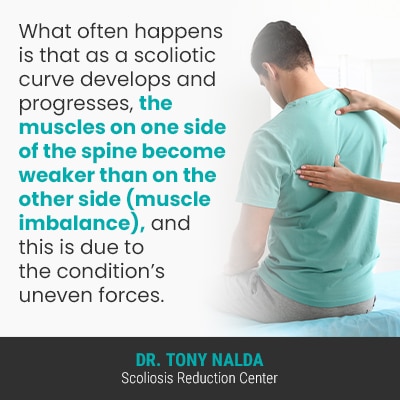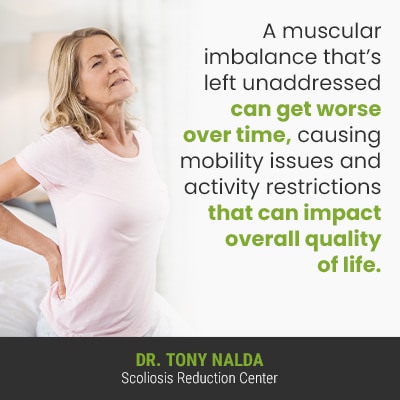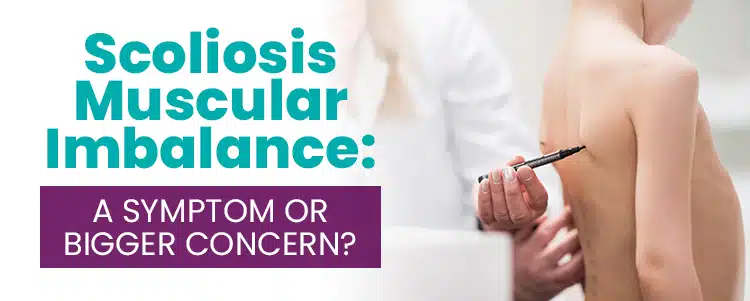It’s not just the spine’s job to maintain its natural curves and alignment, but also its surrounding muscles. If the muscles on one side of the spine are underused, while the muscles on the other side are overused, a muscular imbalance can occur. Continue reading to learn more about the effects of a scoliosis muscular imbalance.
Scoliosis introduces a lot of uneven forces to the body, which is why one of its main symptoms is postural deviation, involving a disruption to the body’s overall symmetry. A muscular imbalance can occur as the muscles surrounding the spine struggle to support the unnatural spinal curve.
Scoliosis can affect the body in a number of ways, including the development of a muscular imbalance, but let’s start with some general condition characteristics.
Understanding Scoliosis
When a person is diagnosed with scoliosis, it means their spine has developed an unnatural sideways curvature that also rotates, making scoliosis a 3-dimensional condition.
Let’s take a minute and think about the roles of the spine; it allows us to stand upright and practice good posture, gives the body structure, protects vital organs, enables flexible movement, and works with the brain to form the body’s central nervous system (CNS).
The CNS is a complex communication network that allows the brain to communicate with the rest of the body, which is why the spine is involved in the function of virtually every working system within the body, and also why spinal conditions can cause so many different effects.
The spine’s natural curves make it more flexible, better able to evenly distribute and absorb mechanical stress incurred during activity, and stronger, like a coiled spring.
If the spine loses one or more of its natural and healthy curves, it disrupts the overall biomechanics, function, and health of the spine, which is what happens with scoliosis.
When it comes to fully understanding scoliosis, and its effects, progression is a key factor.
Scoliosis is Progressive
As a progressive condition, scoliosis has it in its nature to worsen over time, especially if left untreated, and condition effects and symptoms tend to escalate alongside progression, so for those experiencing muscle pain and/or imbalance, if not treated proactively, it can become more severe.
A patient’s severity level is determined by a measurement known as Cobb angle, and the higher the Cobb angle, the more severe the condition, and the more likely it is that its effects will be noticeable.
- Mild scoliosis: Cobb angle measurement of between 10 and 25 degrees
- Moderate scoliosis: Cobb angle measurement of between 25 and 40 degrees
- Severe scoliosis: Cobb angle measurement of 40+ degrees
- Very-severe scoliosis: Cobb angle measurement of 80+ degrees
As you can tell from the wide range of severity levels, what one patient experiences isn’t necessarily indicative of what others will face, nor is a scoliosis severity level, at the time of diagnosis, indicative of where it will be in the future.
In mild cases, the condition’s symptoms and effects also tend to be mild, which is why early detection isn’t always easy to achieve, and the severity levels are the condition’s progressive line, so scoliosis diagnosed as mild, with no related muscle pain/imbalance at the time, can easily progress to the point of causing overt symptoms.
Common Scoliosis Symptoms
Symptoms will vary from patient to patient and depend on key patient/condition variables such as patient age, condition type (cause), curvature location, and condition severity.
When it comes to condition type, the most common form of scoliosis is adolescent idiopathic scoliosis (AIS), diagnosed between the ages of 10 and 18.
The other main types of scoliosis are neuromuscular, degenerative, and congenital scoliosis, so symptoms and condition effects can also vary based on the type in question.
Scoliosis doesn’t become a compressive condition until adulthood is reached, which is when it tends to become painful, at least in terms of localized back pain and radiating pain felt throughout the body due to nerve compression; however, approximately 20 percent of adolescents experience muscle pain.
The main symptom of scoliosis in adults is pain, but in children and adolescents who are still growing, it’s postural deviation:
- Uneven shoulders
- Uneven shoulder blades
- The development of a rib arch
- An uneven waistline
- Arms and legs that appear to hang at different lengths
With these types of postural changes in mind, it’s clear that the body’s muscles could also be affected.
Scoliosis and Muscles
As mentioned earlier, the muscles that surround the spine play the role of supporting the spine’s natural curves and alignment.
So what happens to the muscles surrounding the spine as an unnatural spinal curve develops, and worsens, over time?
The back muscles on each side of the spine have to work hard; they provide structural support for the torso, help move the neck, head, shoulders, arms, legs, and the entire body.
The back muscles combine forces to facilitate bending, twisting, and turning motions, and they are affected by the development of a scoliotic curve.

What often happens is that as a scoliotic curve develops and progresses, the muscles on one side of the spine become weaker than on the other side (muscle imbalance), and this is due to the condition’s uneven forces.
How Does Scoliosis Cause Muscular Imbalance?
People with scoliosis can end up with one side of the back being stronger than the other, and this is due to muscular imbalance that develops as muscles along one side of the spine are overused, while muscles on the other side are underused.
The muscles that are overused are having to work harder to counteract the uneven forces of the condition and support the unnaturally-curved spine; both under- and over-used muscles are problematic.
In most typical cases of scoliosis, the unnatural spinal curve bends to the right, away from the heart, which forces the muscles on the right side of the spine to work harder, and this can cause them to become stretched due to overuse; the muscles on the left side will slowly become smaller, tighter, and weaker from underuse.
So exactly how serious is a scoliosis muscular imbalance, and how does it feel?
What are the Effects of a Scoliosis Muscular Imbalance?
Once a muscular imbalance has occurred, if a condition progresses, this means the unnatural spinal curve is increasing in size, which means the uneven forces of the condition are also increasing, and the back muscles are also going to feel the condition’s effects increasingly.
It is, indeed, problematic when one side of the body is weaker than the other; for one, it can cause a lot of pain and related discomfort.
Some muscles are sore because they are overworked, while those that are left underused will shrink in size, become weaker, and start to atrophy (the wasting away and/or thinning of muscle tissue).

A muscular imbalance that’s left unaddressed can get worse over time, causing mobility issues and activity restrictions that can impact overall quality of life.
For people with scoliosis, reduced mobility is already a potential effect, and for those who enjoy participating in sports, a muscular imbalance only exacerbates the condition’s effects, which is why people with scoliosis are already told to approach certain sports/activities with caution.
For example, some scoliosis patients are restricted from participating in sports that overuse one side of the body like tennis or golf, and this is to avoid increasing levels of muscle imbalance, which scoliosis patients are already vulnerable to.
Conclusion
So scoliosis muscular imbalance is a condition effect that should, indeed, be taken seriously.
As an unnatural spinal curve develops, it introduces a lot of uneven forces not just to the spine, but also its surrounding ligaments, nerves, and muscles.
As the muscles that surround the spine struggle to support it, despite its unnatural curve and rotation, muscles on one one side become overworked and strained, while muscles on the other side become underused and weak.
A scoliosis muscular imbalance can be painful and cause mobility issues that impact quality of life.
The good news is that although scoliosis is progressive, it can be highly treatable, especially if caught early and treated proactively.
Here at the Scoliosis Reduction Center®, I believe in starting treatment as close to the time of diagnosis as possible so progression, and escalating symptoms and condition effects, can be avoided.
I use a conservative chiropractic-centered treatment approach that integrates multiple treatment disciplines to impact the condition on every level, and through physical therapy and a variety of scoliosis-specific exercises (SSEs), muscle imbalance can be addressed.
In fact, increasing core strength is an important focus of modern conservative scoliosis treatment as we now understand that it’s not just the spine that has to maintain its natural cures and alignment, but also its surrounding muscles.
Through chiropractic care, I can work towards reducing the scoliotic curve on a structural level, which takes pressure off the spine, and its surrounding muscles, and once I see those kinds of structural results, I shift the focus to working on core strength, which includes addressing any areas of muscle imbalance.
The best time to start scoliosis treatment is always now; with early detection and proactive treatment, the condition’s effects, such as muscle pain and imbalance, can be minimized and/or resolved.




